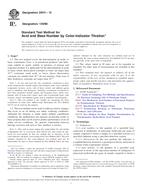Potřebujeme váš souhlas k využití jednotlivých dat, aby se vám mimo jiné mohly ukazovat informace týkající se vašich zájmů. Souhlas udělíte kliknutím na tlačítko „OK“.
ASTM D974-12
Standard Test Method for Acid and Base Number by Color-Indicator Titration
Automaticky přeložený název:
Standardní zkušební metoda pro Acid a Base Number by Color - Ukazatel titrace
NORMA vydána dne 15.4.2012
Informace o normě:
Označení normy: ASTM D974-12
Poznámka: NEPLATNÁ
Datum vydání normy: 15.4.2012
Kód zboží: NS-39953
Počet stran: 7
Přibližná hmotnost: 21 g (0.05 liber)
Země: Americká technická norma
Kategorie: Technické normy ASTM
Anotace textu normy ASTM D974-12 :
Keywords:
acid number, base number, color indication titration, petroleum products, ICS Number Code 75.080 (Petroleum products in general), 75.100 (Lubricants, industrial oils and related products)
Doplňující informace
| Significance and Use | ||||||||||
|
New and used petroleum products can contain basic or acidic constituents that are present as additives or as degradation products formed during service, such as oxidation products. The relative amount of these materials can be determined by titrating with acids or bases. This number, whether expressed as acid number or base number, is a measure of this amount of acidic or basic substances, respectively, in the oilalways under the conditions of the test. This number is used as a guide in the quality control of lubricating oil formulations. It is also sometimes used as a measure of lubricant degradation in service; however, any condemning limits must be empirically established. Since a variety of oxidation products contribute to the acid number and the organic acids vary widely in corrosive properties, the test cannot be used to predict corrosiveness of an oil under service conditions. No general correlation is known between acid number and the corrosive tendency of oils toward metals. Compounded engine oils can and usually do have both acid and base numbers in this test method. |
||||||||||
| 1. Scope | ||||||||||
|
1.1 This test method covers the determination of acidic or basic constituents (Note 1) in petroleum products and lubricants soluble or nearly soluble in mixtures of toluene and isopropyl alcohol. It is applicable for the determination of acids or bases whose dissociation constants in water are larger than 10−9; extremely weak acids or bases whose dissociation constants are smaller than 10−9 do not interfere. Salts react if their hydrolysis constants are larger than 10−9. Note 1—In new and used oils, the constituents considered to have acidic characteristics include organic and inorganic acids, esters, phenolic compounds, lactones, resins, salts of heavy metals, and addition agents such as inhibitors and detergents. Similarly, constituents considered to have basic properties include organic and inorganic bases, amino compounds, salts of weak acids (soaps), basic salts of polyacidic bases, salts of heavy metals, and addition agents such as inhibitors and detergents. Note 2—This test method is not suitable for measuring the basic constituents of many basic additive-type lubricating oils. Test Method D4739 can be used for this purpose. 1.2 This test method can be used to indicate relative changes that occur in an oil during use under oxidizing conditions. Although the titration is made under definite equilibrium conditions, the method does not measure an absolute acidic or basic property that can be used to predict performance of an oil under service conditions. No general relationship between bearing corrosion and acid or base numbers is known. Note 3—Oils, such as many cutting oils, rustproofing oils, and similar compounded oils, or excessively dark-colored oils, that cannot be analyzed for acid number by this test method due to obscurity of the color-indicator end point, can be analyzed by Test Method D664. The acid numbers obtained by this color-indicator test method need not be numerically the same as those obtained by Test Method D664, the base numbers obtained by this color indicator test method need not be numerically the same as those obtained by Test Method D4739, but they are generally of the same order of magnitude. 1.3 The values stated in SI units are to be regarded as standard. No other units of measurement are included in this standard. 1.4 This standard does not purport to address all of the safety concerns, if any, associated with its use. It is the responsibility of the user of this standard to establish appropriate safety and health practices and determine the applicability of regulatory limitations prior to use. |
||||||||||
| 2. Referenced Documents | ||||||||||
|
Doporučujeme:
Aktualizace technických norem
Chcete mít jistotu, že používáte pouze platné technické normy?
Nabízíme Vám řešení, které Vám zajistí měsíční přehled o aktuálnosti norem, které používáte.
Chcete vědět více informací? Podívejte se na tuto stránku.




 Cookies
Cookies
